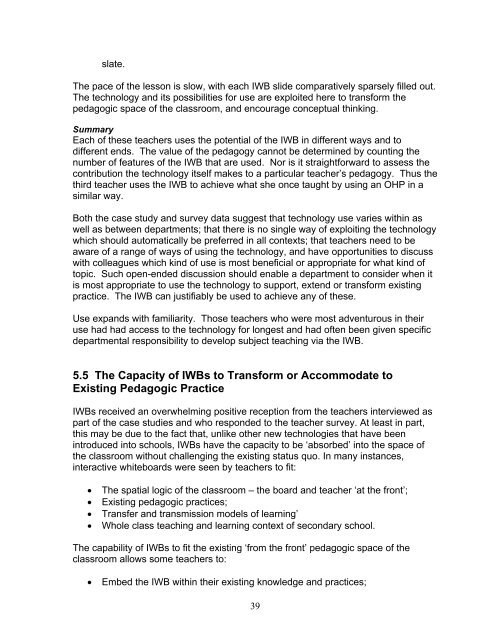The Interactive Whiteboards, Pedagogy and Pupil Performance ...
The Interactive Whiteboards, Pedagogy and Pupil Performance ...
The Interactive Whiteboards, Pedagogy and Pupil Performance ...
Create successful ePaper yourself
Turn your PDF publications into a flip-book with our unique Google optimized e-Paper software.
slate.<br />
<strong>The</strong> pace of the lesson is slow, with each IWB slide comparatively sparsely filled out.<br />
<strong>The</strong> technology <strong>and</strong> its possibilities for use are exploited here to transform the<br />
pedagogic space of the classroom, <strong>and</strong> encourage conceptual thinking.<br />
Summary<br />
Each of these teachers uses the potential of the IWB in different ways <strong>and</strong> to<br />
different ends. <strong>The</strong> value of the pedagogy cannot be determined by counting the<br />
number of features of the IWB that are used. Nor is it straightforward to assess the<br />
contribution the technology itself makes to a particular teacher’s pedagogy. Thus the<br />
third teacher uses the IWB to achieve what she once taught by using an OHP in a<br />
similar way.<br />
Both the case study <strong>and</strong> survey data suggest that technology use varies within as<br />
well as between departments; that there is no single way of exploiting the technology<br />
which should automatically be preferred in all contexts; that teachers need to be<br />
aware of a range of ways of using the technology, <strong>and</strong> have opportunities to discuss<br />
with colleagues which kind of use is most beneficial or appropriate for what kind of<br />
topic. Such open-ended discussion should enable a department to consider when it<br />
is most appropriate to use the technology to support, extend or transform existing<br />
practice. <strong>The</strong> IWB can justifiably be used to achieve any of these.<br />
Use exp<strong>and</strong>s with familiarity. Those teachers who were most adventurous in their<br />
use had had access to the technology for longest <strong>and</strong> had often been given specific<br />
departmental responsibility to develop subject teaching via the IWB.<br />
5.5 <strong>The</strong> Capacity of IWBs to Transform or Accommodate to<br />
Existing Pedagogic Practice<br />
IWBs received an overwhelming positive reception from the teachers interviewed as<br />
part of the case studies <strong>and</strong> who responded to the teacher survey. At least in part,<br />
this may be due to the fact that, unlike other new technologies that have been<br />
introduced into schools, IWBs have the capacity to be ‘absorbed’ into the space of<br />
the classroom without challenging the existing status quo. In many instances,<br />
interactive whiteboards were seen by teachers to fit:<br />
• <strong>The</strong> spatial logic of the classroom – the board <strong>and</strong> teacher ‘at the front’;<br />
• Existing pedagogic practices;<br />
• Transfer <strong>and</strong> transmission models of learning’<br />
• Whole class teaching <strong>and</strong> learning context of secondary school.<br />
<strong>The</strong> capability of IWBs to fit the existing ‘from the front’ pedagogic space of the<br />
classroom allows some teachers to:<br />
• Embed the IWB within their existing knowledge <strong>and</strong> practices;<br />
39

















